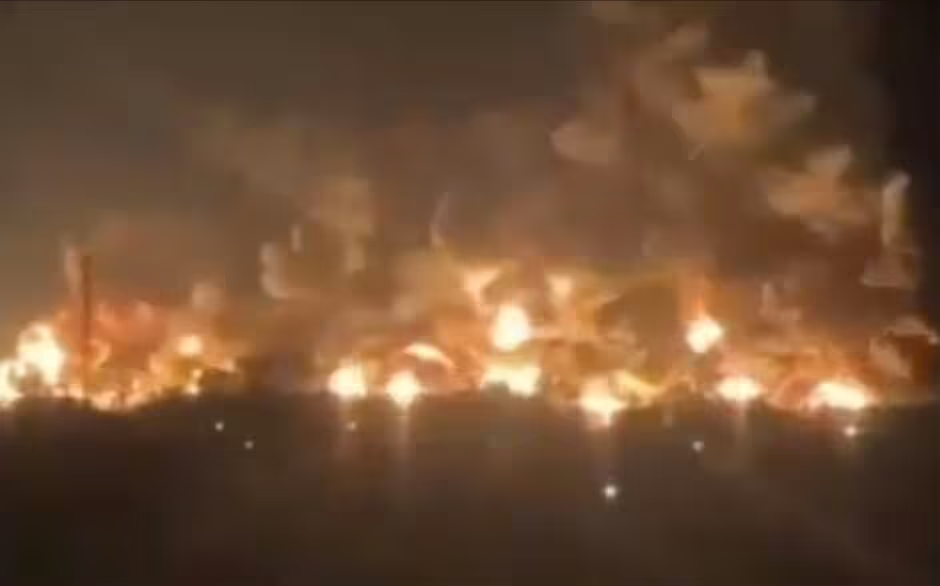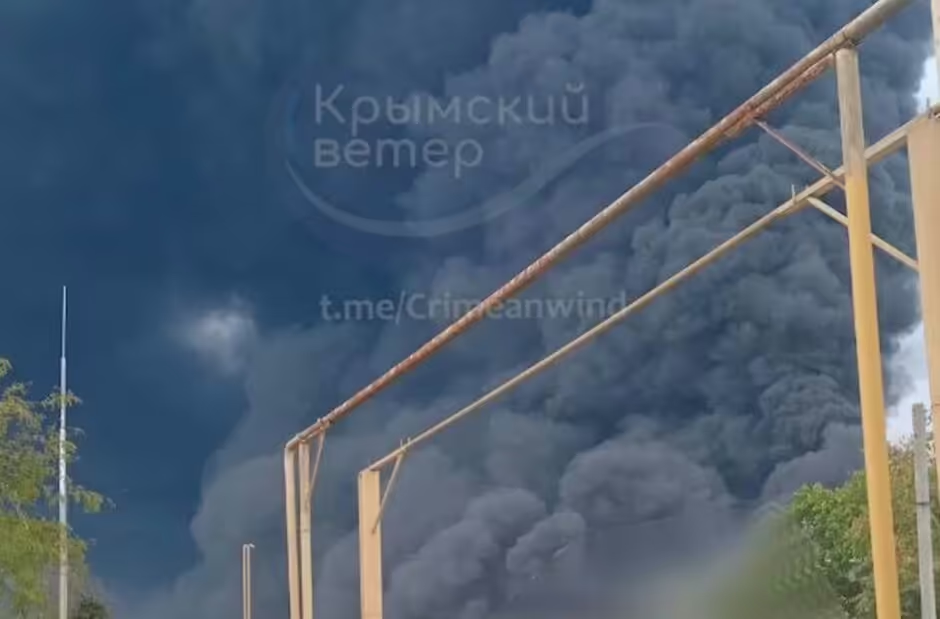Ukraine Launches Major Drone Strike Destroying 16 Russian Oil Tanks at Key Port — A Strategic Attack That Could Change the War’s Momentum
The glow of burning fuel storage tanks lit up the night sky along Russia’s Black Sea coastline, and for a moment, it was impossible to ignore what had happened. Ukraine, which has spent nearly two years defending cities, power stations and infrastructure from Russian missiles and drones, struck deep inside Russian territory again — but this time with a level of precision and impact that instantly captured global attention. Ukrainian long-range drones hit a major oil port facility, reportedly damaging or destroying 16 oil tanks in what one military analyst described as “a textbook example of hitting a high-value target with strategic intent.”

The location matters. The port facility was not a small depot feeding local trucks. It was a key node in Russia’s oil export chain, a distribution point connecting inland pipelines to global shipping lanes. Satellite imagery captured after the strike showed multiple fires burning simultaneously, spaced in a pattern that suggested coordinated impact rather than random explosion. Footage posted on Telegram channels known for frontline reporting showed glowing embers and rising flames inside a facility Russia had described for years as secure and protected. Local authorities confirmed that fire crews were deployed, flights were restricted, and nearby operations were halted.
For Ukraine, the message was unmistakable: the war is no longer confined to trenches and artillery duels along the front lines. Kyiv has increasingly invested in long-range drone development, and this strike reinforces what officials have hinted for months — Ukraine intends to dismantle the logistics and economic structure fueling Russia’s war effort. The tactic is not new in modern warfare, but the scale of this strike suggests a move from opportunistic targeting to systematic disruption. Oil flows are not just economic assets; they are military enablers. They power vehicles, aircraft, naval assets and transport systems. Cutting them off is an attack on capability, not only commerce.

Russian officials acknowledged a fire at the site but did not confirm the number of tanks hit. Some local reports attempted to downplay the incident, calling it a localized blaze that was “quickly controlled.” Yet maritime tracking data told a different story — tanker movements were temporarily halted, and shipping analysts monitoring the Black Sea corridor noted a pause in vessel departures. That slowdown may not cripple Russia’s export sector, but it signals vulnerability. One successful strike forces new defensive investments, new risk calculations and renewed uncertainty in a war Russia once hoped it could fight from fortified distance.
Ukraine did not officially claim responsibility in the first hours after the attack, consistent with its pattern in earlier long-range strikes. However, senior officials have repeatedly stated that fuel hubs, logistics bases and strategic industry inside Russia are legitimate military targets. Their argument rests on a simple premise: if Russia can target Ukrainian power plants, ports and residential areas with drones and missiles, then Ukraine has the right to strike objects that directly support Russia’s military operations, including fuel depots.
Western analysts remain divided over how much these strikes genuinely degrade Russia’s war capacity. Some argue that disrupting oil exports forces Russia to divert resources away from frontline operations and complicates its broader economy. Others say Russia’s energy sector is large enough to absorb isolated damage, especially if infrastructure can be repaired quickly. But nearly all agree on one point: the psychological impact inside Russia is significant. The Kremlin spent the first year of the war claiming that life inside Russian borders would remain untouched — calm, supplied and secure. That narrative has been weakened by earlier strikes on airbases, power facilities and refineries. This latest attack reinforces the reality that distance no longer guarantees protection.

The technology enabling these strikes is evolving rapidly. Ukrainian engineers have developed drones capable of traveling hundreds of miles, navigating autonomously and striking without real-time operator control. The cost of these systems is dramatically lower than conventional missiles, and Ukraine has begun deploying them in clusters designed to overwhelm air defenses. Fragments recovered inside Russia suggest that many components were produced domestically inside Ukraine, not imported. In effect, Ukraine is building an independent strategic strike capability under wartime pressure, with contributions from thousands of volunteer engineers and private manufacturers.
Moscow’s response is also changing. Air defense systems across western Russia have been reinforced, and officials routinely claim to intercept most incoming drones. But even if only a few reach their targets, the damage can be serious. That asymmetry defines Ukraine’s strategy: Russia must spend millions defending vast territory, while Ukraine spends a fraction to strike selectively. It mirrors Russia’s own logic during its missile campaigns against Ukrainian power grids — only now, the roles are reversed.
The international reaction has been cautious. Energy markets recorded a small price increase as traders evaluated the risk of prolonged export disruption. NATO officials continue to state publicly that Ukraine has the right to strike legitimate military targets inside Russia. At the same time, Western governments avoid appearing to encourage escalation. The United States does not allow Ukraine to strike inside Russia with American-supplied long-range missiles — but it does not restrict the use of Ukrainian-built systems.
For Ukrainians following the news, the strike drew a familiar mix of relief and defiance. Social media filled with comments saying, “Now Russia knows how it feels,” alongside images of earlier missile damage in Kyiv, Odesa and Kharkiv. Every Ukrainian city still bears scars of Russian attacks, and many citizens view operations against oil depots not as escalation but as justified retaliation. For Russians living near the blast areas, the reaction was very different. Videos posted by residents showed bright orange flames on the horizon, followed by emergency sirens — a stark reminder that the conflict often described as far away is no longer distant.
The broader strategic question is whether these strikes represent a new phase of the war. If Ukraine continues targeting oil terminals, refineries and export infrastructure, will Russia escalate beyond Ukrainian territory? Will it strike Western facilities or cyber-attack European energy grids? So far, Moscow’s response has remained within Ukraine, and its public statements have been more warning than action. However, Kremlin-aligned commentators have already started referring to Western supporters as “direct participants” — language often used before Russia attempts to justify retaliation.
What remains certain is that Ukraine is no longer fighting a purely defensive war. It is shaping the battlefield by forcing Russia to react, absorb losses and spend resources in places it once considered safe. The drone war, once seen as a technological experiment, is maturing into a strategic weapon. Every successful strike reminds Russian planners that no industrial facility supporting the war effort is beyond reach.
In the coming weeks, analysts will watch tanker schedules, refinery output reports and new satellite imagery to assess how long the damage will last. Whether the port resumes full operations in days or weeks, the psychological and financial cost has already been inflicted. Ukraine has demonstrated the ability to reach into the economic heart of Russia’s military machine — and light it on fire.
The war may continue for months or years. Territorial advances may remain slow. But overhead, above ports, refineries and fuel depots that once seemed untouchable, the nature of the conflict is changing. Not with jet formations or cruise missiles, but with unmanned aircraft gliding silently over hundreds of miles before choosing exactly where to strike — and proving, once again, that this is not the same war it was even one year ago.


